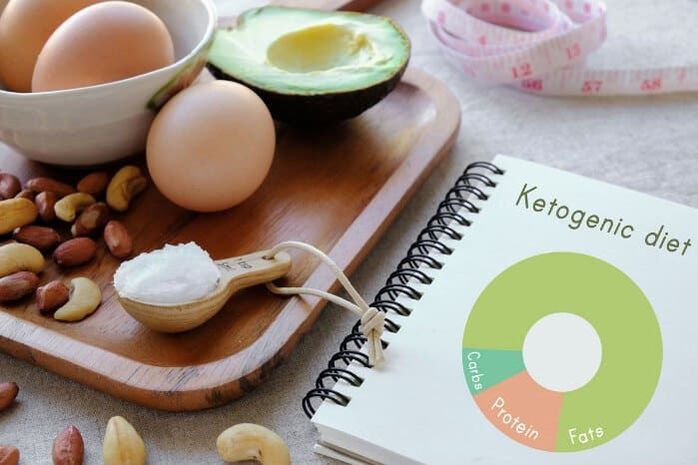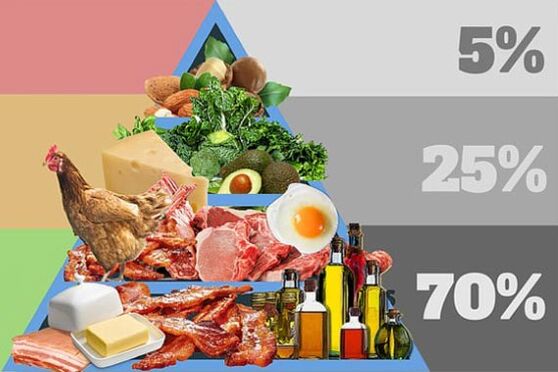The keto diet is a low-carb diet with moderate protein and high fat content.Clinical studies have shown that the keto diet produces results that have not previously been achieved without the help of medications for diabetes, epilepsy, cancer and Alzheimer's disease.
Keto diet: More about the nutritional system and ketosis
The goal of the ketogenic diet is to force the body to use fat as its main source of energy.As a rule, this process occurs differently: carbohydrates consumed with food are processed into glucose - the basis for the function and nutrition of the brain and the cell structures of other organs.If you limit the amount of carbohydrates, the liver converts fats into ketone bodies.

Experts recommend a ketogenic diet for the following diseases:
- diabetes, epilepsy and autism;
- Alzheimer's disease and brain cancer;
- stroke, depression, Parkinson's and Charcot diseases;
- schizophrenia, head trauma and hyperactivity;
- obesity, irritable bowel syndrome and tremors;
- Cardiovascular disease and respiratory failure.
To understand how the keto diet affects the body, you need to understand the process of ketosis.For full functioning, a person needs a sufficient amount of energy in ATP format (a universal source needed for biochemical processes).On average, you need about 1800 kcal per day.About 400 kcal comes from the brain - that's 100 g of glucose.What happens to the body when carbohydrates are almost completely eliminated from the diet?
Ketosis is a process characterized by using fats as the main source of energy while minimizing carbohydrates.Without additional effort, as a natural process, similar changes can be observed in the body in infancy and in women during pregnancy.
During ketosis, insulin levels drop, causing fatty acids to leave the fatty tissue in large quantities.The oxidation process takes place in the liver, where ketones (organic substances) are formed - sources of energy for the body.They penetrate the blood-brain barrier and nourish the brain cells.
When considering biochemical processes in more detail, special attention should be paid to the process of “fat burning”.Fatty acid molecules are processed into acetyl-CoA.This element combines with oxaloacetate and triggers the Krebs cycle, which occurs in the mitochondria of cells.This process creates vital substances.
Reducing sugar and insulin has a positive effect on the health of internal organs and systems.Ketosis is a safer process than glucose metabolism because no free radicals are formed, which is essential in old age.Ketones are automatically produced in the body when the diet contains less than 30 grams of carbohydrates per day and 0.8-1.5 grams of protein per 1 kg of body weight.At the same time, high-quality saturated fats (butter, egg yolks, lard and lard, etc.) are needed in sufficient quantities.
The benefits of ketones for our body are as follows:
- Internal organs and tissues (heart, brain, kidneys) work much more efficiently.
- A healthy heart is surrounded by thick fatty tissue, without which it cannot beat well.
- The brain works 25% more efficiently than when glucose is present in the blood.
Ketones are an ideal fuel for cell structures and are non-destructive and non-flammable.They do not glycate, so they do not contribute to cell aging and do not shorten human life expectancy.Healthy ketosis starves cancer cells and increases mitochondrial function, which helps produce more energy in a reliable and sustainable way.
The difference between a ketogenic diet and a low-carb diet
Only a regular carbohydrate deficit allows ketosis to be achieved.This process becomes permanent and is characterized by a noticeable increase in the level of ketone bodies in the blood.With a low-carbohydrate diet, such processes are not observed, since the amount of carbohydrates and fats that enter the body with food every day is completely sufficient for energy needs.
If we talk about the keto diet, then this nutritional system is designed in such a way that ketones are synthesized in large quantities in the liver and used as fuel.With ketosis caused by nutritional correction, the indicators reach values from 0.5 to 3.0 mmol / l.To determine the amount of ketone, you can use special test strips that are available in pharmacies.Such results cannot be achieved with a low-carb diet.
The ketogenic diet affects the body on several levels at the same time.Mitochondria are originally designed to use dietary fat as an energy source.This reduces the burden of toxins on cells and reduces the amount of free radicals (waste).Mitochondrial health is an important key to optimal health.The ketogenic diet is the best way to maintain proper balance.
Indications for the ketogenic diet:
- Diabetes – aiming to reduce insulin levels, increase mitochondriogenesis and increase insulin sensitivity.
- Risks of developing cardiovascular diseases (cholesterol and triglycerides in the blood) – increasing LDL levels and decreasing insulin levels.
- Obesity – to reduce appetite, reduce lipogenesis and reduce energy consumption for the thermic action of proteins.
- Epilepsy – suppression of neuronal excitability and anticonvulsant effects of ketones.
It is not scientifically proven, but most experts claim that the keto diet helps treat acne and neurological diseases.Ketosis is effective against polycystic diseases and cancer.
What is the “adaptation phase”?
Many reviews of the ketogenic diet indicate that some time after changing the diet, mental fog appears, health worsens, and energy is lost.We are talking about an adaptation that lasts in the first few weeks after starting the diet.This is due to the fact that there are not enough enzymes for full life activity and oxidative processes occur more slowly.
In the “adaptation phase” the body is restructured to use other energy resources.The internal organs begin to absorb not carbohydrates, but ketone bodies by breaking down fats supplied with food.The body's condition returns to normal only after 4-6 weeks.
Results of the research
Results of clinical studies on the effectiveness and safety of the ketogenic diet:
- Improved body composition.With a keto diet, you consume 10,000 calories less each day than with a regular diet.At the same time, body weight decreases every day against the background of a reduction in fat deposits.
- Decreased performance during high-intensity workloads.In the first 30 days after changing your diet, your ability to exercise at high intensity decreases.This is because intramuscular and hepatic glycogen decreases.
- Reduction of intramuscular reserves.Characterized by a decrease in glucose supplied with food.This is accompanied by a decrease in the body's recovery speed and ability to build muscle mass.
The conclusion is obvious: the ketogenic diet is optimal and effective for healing the body, but cannot be used to build muscle.Ketosis is an essential process through which you can lose weight with health benefits.
The keto diet is often used by athletes who participate in cyclic sports that require endurance (cycling, triathlon, marathon, etc.).This is because during ketosis the body effectively burns fat to produce energy, allowing you to conserve existing glycogen reserves during excessive respiratory stress.
Eat
With proper preparation of the diet, the results of the ketone diet will appear within 2-3 weeks.After 1-2 years the condition improves in 90% of cases.If you make mistakes, the positive effect may never come.

Permitted oils and fats
Products containing these elements form the basis of the keto diet.
You need to eat the right fats, exclude unhealthy ones:
- monounsaturated (macadamia nut, avocado, olive oil, egg yolk);
- polyunsaturated (fatty fish and animal protein).
It is unacceptable to include trans fats in your diet - processed foods that have undergone a hydrogenation process to extend shelf life, for example margarine.
It is important to have a balanced ratio of Omega-3 (shellfish, trout, tuna, krill and salmon) and Omega-6 (walnuts, almonds, pine nuts, corn and sunflower oil).It is recommended to consume fatty meats and fish in small quantities.
The food should be fried in beef fat, coconut oil or melted butter.This cooking approach allows you to consume more essential fatty acids.
Protein on a keto diet
The higher the concentration of a certain substance in a product, the less of it should be consumed.It is better to give preference to meat from grass-fed and pasture-fed animals.This eliminates the possibility of consuming steroids and harmful bacteria.Dark meats (poultry) are preferred.
Note that excessive amounts of protein can decrease ketone synthesis and increase glucose production.The diet should contain no more than 35% protein food, which must be balanced with sauces and rich side dishes.For example, lean beef should be eaten with whole cheese.Pork can be replaced with lamb without affecting ketosis.
Healthy fish include cod, trout, tuna, catfish and mackerel.It is imperative to add shellfish (crabs, lobsters, oysters, squid or mussels) to your diet.An important source of protein is the chicken egg.It is best to buy the product from free-range chickens.Useful poultry - duck, chicken, pheasant;Offal - tongue, liver and heart.
Fruits and vegetables for ketosis
You need to exclude products of plant origin that contain large amounts of glucose.The best type of vegetable is one that contains a lot of nutrients and a minimum of carbohydrates (leafy and green).Highlights include asparagus, peppers, broccoli, spinach, cauliflower and Brussels sprouts.
Vegetables growing underground should be limited as they accumulate carbohydrates.They are recommended, for example, for frying onions and carrots.In small quantities, you can eat citrus fruits, berries (blueberries, blackberries and raspberries), nightshades (eggplants and tomatoes) and root vegetables (mushrooms, garlic, parsnips).
Dairy products on the keto diet
Whole milk can only be drunk with the main meal.In this case, moderation is important.Organic raw milk products should be preferred.If you are lactose intolerant, it is recommended to stick with hard cheeses.
Healthy foods recommended for a ketogenic diet include:
- whipped cream and Greek yogurt;
- homemade mayonnaise and soft cheeses (brie, mozzarella);
- Parmesan, Cheddar, Swiss cheese;
- Sour cream, cottage cheese, cream nuts, mascarpone.
Dairy products are often used in the preparation of sauces and fatty side dishes.If you are following a keto diet to reduce body weight, it is recommended to limit these foods.
Drinks and water to produce ketones
The aim of the ketogenic diet is to achieve a natural diuretic effect.For this reason, most people tend to become dehydrated.To eliminate possible negative effects on the body, it is recommended to drink at least 4 liters of water per day.
Bitte beachten Sie, dass Koffein zu einem Flüssigkeitsverlust im Körper führt, weshalb belebende Getränke (Tee und Kaffee) auf 2 Tassen pro Tag reduziert werden sollten.To eliminate the likelihood of keto flu, which is typical of improper adherence to a keto diet, you should learn to compensate for the lack of electrolytes.To do this, you need to drink bone broth, which can be replaced with sports drinks containing stevia or sucralose.



























































